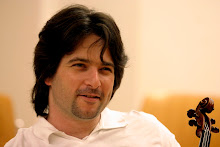The Beam of Light:
When I want to describe a beautiful, attractive sound I use words like ‘pure’, ‘clean’, ‘full’, ‘colorful’ and ‘unified’.
The quality of our sound is the most powerful expressive tool we have, yet I find that many students take their sound for granted and focus their practice on other playing in tune or fast enough. As important as those other subjects are, nothing affects your listeners more than the sound that come out of your instrument. It is your calling card, your essence. With a good sound you could convince anyone to listen to you, while it is not important how in tune you play if no one wants to hear you saw the violin.
Playing the violin well is very difficult: putting the fingers in the right place at the right time, remembering all those notes, battling anxiety and trying to “do the right thing. We get so busy with it, we sometimes tend neglect our sound or ignore those small mistakes such as scratches between notes, slides, uneven vibrato and such. After a while, they become ‘background’ noises and we even stop hearing them altogether.
My best tool for sound is a practicing technique I call “The Beam of Light”. As I slowly practice the piece I imagine a beam of light across my line of vision. The beam width represents the deepness of my sound and its surface, the purity of it. Within the beam there is a second, wavy line, which represents my vibrato in the same way a sound wave could be seen on a monitor.
When I play I ‘watch’ the beam of light with my mind’s eye. If I scratch the sound my beam becomes tarnished or if I hit the string too hard it wobbles and shakes. Your entire focus should be on the ‘now’ and ‘before’, (as opposed to performance practice in which you focus on the future). It is important to practice slower than the actual speed and if possible, by heart. I find this technique incredible effective in developing sound awareness.
The Three stages of Sound
I divide the sound to three stages, which I call ‘head’, ‘body’ and ‘tail’. The ‘head’ is the moment my sound begins, i.e. when the bow touches the string, the ‘body’ is when the bow moves across the string and ‘tail’ represents the way I end the note. Different techniques have different requirements, for example a fast spicatto is all ‘head’, martelle technique is partly about being able to stop the note, while a slow high pitched note which end the piece is very much ‘body’ and ‘tail’.
These three stages represent (mostly) bow techniques, so when I detect a mistake in the sound (using the Beam of Light technique) I define it under one of the three stages and thus understand what I should physically do to correct it.
For example: a scratch in the head of the note indicates a problem in the approach and touch phase of the bow to the string. You may want to alter the way you begin the note by changing the way you start (from the air or from the string), the amount of bow, the relation between speed and weight, the amount of hair which is in contact with the string or several other possibilities.
Note that starting a note from the air or from the string are two different techniques, each with its own timing in approaching the string and its own pros and cons. Some schools of violin prefer one over the other (at this moment in my life, and since I began using the Beam of Light, I use the string technique much more than the approach from the air), but I suggest you master both.
If you detect a sound mistake in the ‘body’ part, you should check if your bow is straight, if you control the movement of the stroke the entire way, if the weight you apply on the stick co-relates to the speed and the changing of the bow flexibility etc.
A ‘tail’ problem is usually about bow control. You need to master not only your approach to the string but how you end a note and whether you decide to stay on the string on need to lift the bow.
There are also mistakes in vibrato such as over or under-use, unevenness either in the ‘body’ of a note or changing it for different fingers, too tight or nervous vibrato and uncontrolled delayed vibrato. Without getting into too much detail (since this book is really about playing Bach, not playing in general): most vibrato mistakes derive from holding don the finger too tight, holding the neck of the violin too hard, and leaving too many fingers down on the string (such as in chords).
Recording yourself is a very good way of assessing your sound, and applying the Beam of Light as a practice method will help you clear your sound from very common mistakes.
Subscribe to:
Post Comments (Atom)

No comments:
Post a Comment